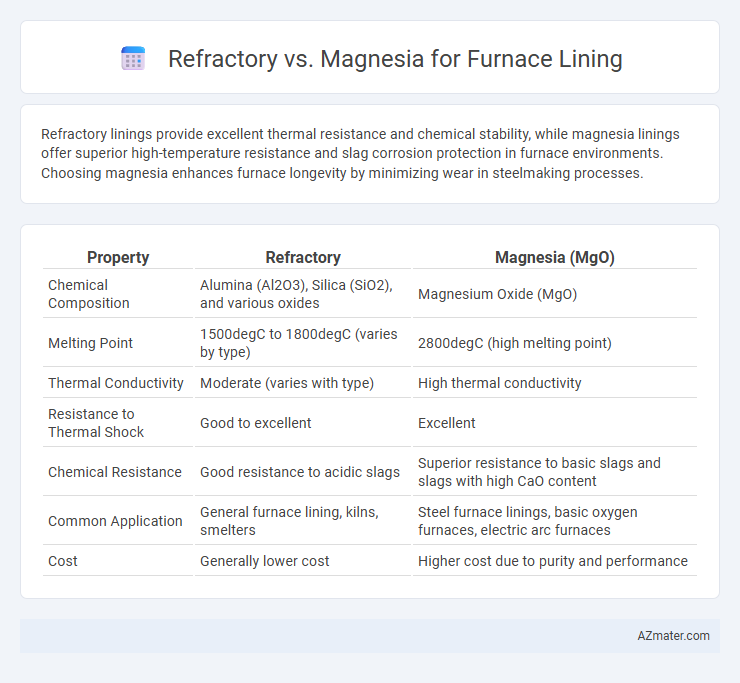Refractory linings provide excellent thermal resistance and chemical stability, while magnesia linings offer superior high-temperature resistance and slag corrosion protection in furnace environments. Choosing magnesia enhances furnace longevity by minimizing wear in steelmaking processes.
Table of Comparison
| Property | Refractory | Magnesia (MgO) |
|---|---|---|
| Chemical Composition | Alumina (Al2O3), Silica (SiO2), and various oxides | Magnesium Oxide (MgO) |
| Melting Point | 1500degC to 1800degC (varies by type) | 2800degC (high melting point) |
| Thermal Conductivity | Moderate (varies with type) | High thermal conductivity |
| Resistance to Thermal Shock | Good to excellent | Excellent |
| Chemical Resistance | Good resistance to acidic slags | Superior resistance to basic slags and slags with high CaO content |
| Common Application | General furnace lining, kilns, smelters | Steel furnace linings, basic oxygen furnaces, electric arc furnaces |
| Cost | Generally lower cost | Higher cost due to purity and performance |
Introduction to Furnace Lining Materials
Furnace lining materials are critical for maintaining thermal insulation and structural integrity under extreme temperatures. Refractory materials, such as fireclay and alumina, offer high resistance to heat and chemical attack, while magnesia-based linings provide superior corrosion resistance against basic slags in steelmaking furnaces. Choosing the appropriate lining depends on factors like operating temperature, furnace atmosphere, and slag composition to ensure optimal performance and longevity.
Understanding Refractory Materials
Refractory materials for furnace linings are crucial for withstanding high temperatures and chemical wear, with magnesia being a common choice due to its high melting point (about 2800degC) and excellent resistance to basic slags. Understanding the composition and thermal properties of magnesia refractories helps optimize furnace durability and efficiency in steel-making and cement industries. Proper selection between acidic, basic, and neutral refractories, like magnesia, depends on the furnace environment's temperature, slag chemistry, and mechanical stress.
Overview of Magnesia as a Lining Material
Magnesia, primarily composed of magnesium oxide (MgO), is a preferred lining material in high-temperature furnace applications due to its excellent thermal resistance and chemical stability. This refractory material offers superior corrosion resistance against basic slags, making it ideal for steel-making processes where molten slags are highly corrosive. Its high melting point and good mechanical strength at elevated temperatures ensure prolonged service life and reduced maintenance costs in industrial furnaces.
Key Properties of Refractory for Furnace Lining
Refractory materials for furnace lining must exhibit high melting points, excellent thermal shock resistance, and low chemical reactivity to withstand extreme temperatures and corrosive environments. Magnesia (MgO) refractory is favored for its superior slag resistance, high refractoriness above 2800degC, and strong basicity, making it ideal for steelmaking furnaces. Key properties such as porosity, mechanical strength, and thermal conductivity critically influence the durability and energy efficiency of furnace linings.
Essential Characteristics of Magnesia Lining
Magnesia lining for furnace applications exhibits exceptional refractory properties such as high melting points above 2800degC, excellent thermal conductivity, and superior resistance to slag corrosion, making it ideal for steelmaking environments. Its essential characteristics include outstanding basicity, which minimizes chemical reactions with acidic slags, and structural integrity under cyclic thermal stresses, ensuring long service life and reduced maintenance. Compared to generic refractory linings, magnesia provides enhanced durability, resistance to thermal shock, and contributes to improved furnace efficiency and operational stability.
Refractory vs Magnesia: Performance Comparison
Refractory linings generally offer superior thermal shock resistance and longer service life compared to magnesia linings, which excel in high-temperature corrosion resistance due to magnesia's intrinsic basicity. Magnesia linings provide enhanced protection against slag and molten metal erosion in steelmaking furnaces, but they may suffer from reduced mechanical strength under cyclic thermal conditions. Performance differences are highlighted by refractory materials' versatility in various furnace environments, while magnesia is preferred for applications requiring high purity and resistance to alkaline slags.
Applications of Refractory in Furnaces
Refractory materials used in furnace linings provide excellent thermal resistance and mechanical strength essential for high-temperature industrial processes such as steelmaking, cement production, and glass manufacturing. Magnesia-based refractories, specifically, excel in applications requiring high basicity and resistance to slag erosion and corrosion in electric arc furnaces or rotary kilns. The selection of refractory types depends on operating temperature, chemical environment, and mechanical stress, ensuring durability and efficiency in furnace performance.
Uses of Magnesia in Industrial Furnace Lining
Magnesia, known for its high melting point and excellent thermal conductivity, is extensively used in industrial furnace linings to withstand extreme temperatures and corrosive environments. Its chemical stability and resistance to slag penetration make it ideal for steel-making furnaces, where durability and performance are critical. Compared to general refractory materials, magnesia linings provide enhanced lifespan and efficiency in high-temperature industrial processes.
Cost Analysis: Refractory vs Magnesia
Refractory materials generally offer lower initial costs compared to magnesia for furnace linings, making them a more budget-friendly choice for short-term projects. Magnesia linings, while having higher upfront expenses, provide superior durability and thermal resistance, leading to reduced maintenance and longer service life, which can lower overall lifecycle costs. Evaluating total cost of ownership, including installation, downtime, and replacement frequency, often reveals magnesia as the more cost-effective solution for high-temperature, high-wear industrial furnaces.
Choosing the Right Lining Material for Furnaces
Choosing the right lining material for furnaces depends heavily on heat resistance, chemical stability, and mechanical strength. Refractory linings made from alumina and silica offer excellent thermal insulation and durability, while magnesia linings provide superior resistance to basic slags and are ideal for steel-making environments. Evaluating the operating temperature, type of furnace, and slag composition ensures optimal performance and extended lifespan of the furnace lining.

Infographic: Refractory vs Magnesia for Furnace lining
 azmater.com
azmater.com